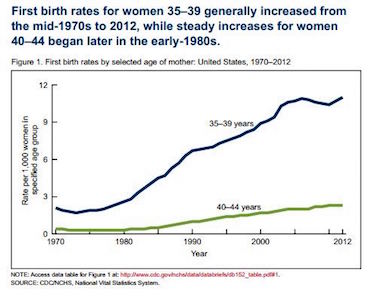Pregnancy over age 35: A numbers game
March 31, 2015

Advanced maternal age. Elderly primipara. Mature gravida. These are all labels placed on women who are having babies when they are age 35 or older.
The descriptions sound a little scary and some statistics about pregnancy at this age can be daunting. But it’s important to look at births in this age group. While total births are falling, the rate of women over the age of 35 who are having their first child has steadily risen since the 1970s.
As obstetricians, we like science and appreciate facts and figures. Women ask us about their risks, and we like to be able to give numerical answers. But those risks need to be categorized and put into the proper perspective.
Age 35 was first designated as the threshold for being labeled as “elderly” while pregnant during a National Institutes of Health (NIH) conference in 1978. The focus of the conference was a new technology – amniocentesis – that would allow testing of a fetus for Down syndrome. We know that as a woman gets older, she is at increased risk for this complication.
The NIH announced that all pregnant women age 35 and older should be offered an amniocentesis, but acknowledged that the specific age was “arbitrarily decided by logistical consequences and is not the sudden biological difference between women above and below any given age.”
Many studies since then have compared outcomes between women under 35 years of age and those older than 35.
For us, the age of 35 is simply a line in the sand. Though all pregnancies are different, this dividing line helps us deliver more precise information to our patients and their babies.
How pregnancy over age 35 can affect the mother and the baby
Both the baby and the mother share the risks associated with pregnancies over age 35.
Risks to the baby
A woman is born with all the eggs she will have. As she ages, so do her eggs. Older eggs have a higher chance of dividing unequally, leading to extra chromosomes in the fetus. Down syndrome is an example of such a condition.
About 1 in 100 babies born to women who become pregnant after the age of 40 have Down syndrome. But remember, that means that 99 percent of babies born to women in this age group will not have Down syndrome.
A woman – regardless of her age – can be screened to determine her risk for chromosome abnormalities, and then can decide whether she chooses to have a diagnostic test like an amniocentesis. Some women who undergo fertility treatments use donated eggs that are younger than their own and are less susceptible to the genetic risks associated with older eggs.
Fetal problems are not always attributed to the mother or her eggs. Mutations can happen in the sperm, especially when the father is older. Diseases like neurofibromatosis or achondroplasia, commonly referred to as dwarfism, are seen more frequently in children whose fathers are over 40 at the time of conception.
Risks to the woman
Trying to become pregnant after age 35 also presents a unique set of problems. In many instances, older women become pregnant through fertility treatments. These treatments can lead to multiple births, which presents additional challenges and higher rates of complications.
All women are at risk for developing complications during pregnancy, but some are more likely as women get older. Women over 35 are more likely to develop gestational diabetes or high blood pressure during pregnancy. Also, there’s a higher chance for women in this age group to have underlying health problems, such as obesity or heart disease. Becoming pregnant with these medical conditions puts the mother at more risk of complications than younger women without them.
These conditions also can lead to premature birth, low birth weight, or other complications. The better controlled medical conditions are before pregnancy, the better the chances for a successful pregnancy.
If you are told you are at a higher risk of a complication than someone younger than 35, don’t focus solely on how much more often it happens. Ask and understand the real probability that it will happen.
It is scary to think that the risk of death during delivery is twice as high if you are 35 to 44 years old than if you are younger than 35 years old. But when you know that the actual occurrence is 1 in 10,000 it can be more reassuring.
What can you do?
Every pregnancy is different. It is critical that women, with their physicians, look closely at risk factors for their particular health status.
If you have high blood pressure, work with your physician to control it with a medication that is safe during pregnancy. If you have diabetes, make sure your glucose levels are normal. Stop smoking. Lose weight. All of these things will have a beneficial impact on your health and that of your baby.
And remember, statistics can be interpreted differently, so don’t get too hung up on the numbers, especially the number 35.










